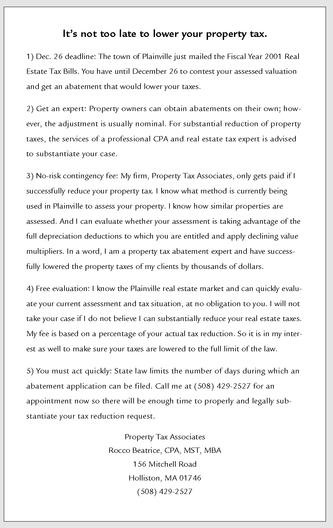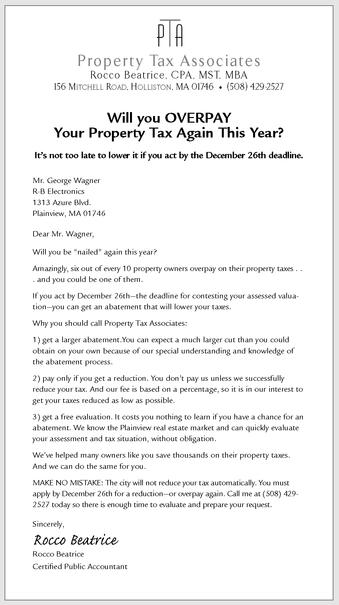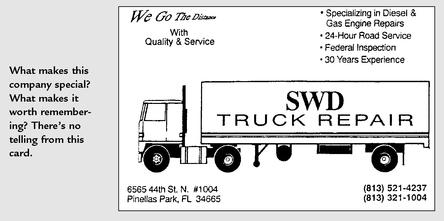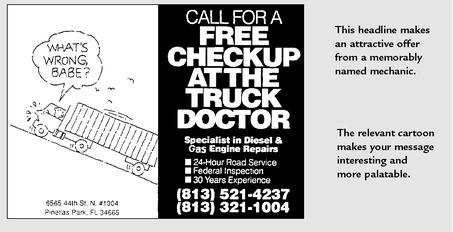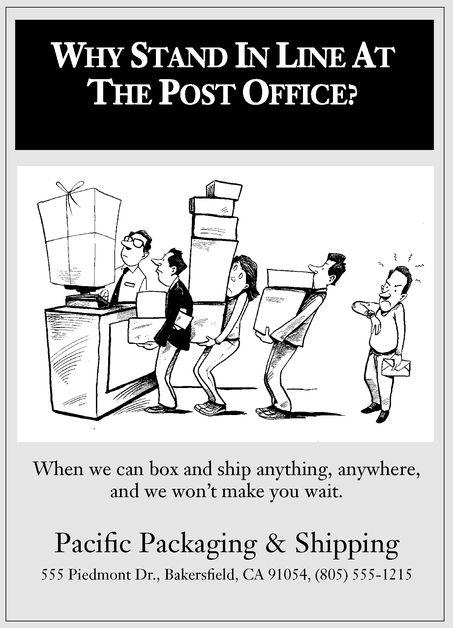Read Start Your Own Business Online
Authors: Inc The Staff of Entrepreneur Media
Start Your Own Business (83 page)
Does this mean the sales letter is dying out? No; people will still read sales letters. However, they don’t like it when you make them work at it—so keep it lean and mean.
Equal in importance to your message (some would say more important) is the look of your letter. It should be visually inviting. As soon as prospective customers pull your letter out of the envelope, before they read one word of your sales message, they instantly have a positive or negative reaction based on the overall look of the letter. If it’s crammed with words, readers will get a negative impression right away.
ADDED DIMENSIONA
dd dimension to your sales letters—literally—by attaching some type of small item to the letter. Make it something that ties in to the letter’s headline or subject. For example:• A plumber could stick a minipacket of aspirin to a letter with a headline reading “Pipes giving you a headache? Take two of these, and call us in the morning.”• Child’s plastic play scissors attached to the letter could be combined with a “Cut your costs ...” message.• Or try a packet of coffee with a headline like “Sit down, have a cup of coffee on us, and learn how you can profit from stocking Steve’s Safety Bolts.”A 3-D item inside gives your direct-mail package bulk. Recipients are curious and more likely to open the letter. Once they see what’s inside, they’ll read on to find out the connection between the item and the words.
To have the best chance of being read, your letter should be open and airy-looking with short paragraphs—including some that are one sentence or even one word long. (A one-word paragraph? Here’s how: Write something like “I have one word for suppliers who say they can’t offer you a one-year guarantee.” Follow that with a one-word paragraph such as “Baloney!” or any similar word you want to use. It is a real attention-getter.)
Strip your sales message down to the essentials so readers can breeze through it. This may mean hacking out words and phrases you have slaved over. But each extra bit you take out increases your chances of actually getting a response.
Last but not least, be sure to use “you.” This is a good rule of thumb in any form of advertising, but especially in a sales letter, where you are, in a sense, talking to the prospect face-to-face. Always talk about your product or service in terms of its benefit to the reader, such as “You’ll save more than 50 percent.” Sounds obvious, but it’s easy to lapse into the impersonal “we” mode, as in “We offer our customers discounts of more than 50 percent.”
TIPIt’s easy to get caught up in marketing campaigns that bring sales from new customers yet overlook the importance of retaining existing customers. It’s less expensive to upsell an old customer than to win a new one, so you need to strike a balance between acquisition and retention tactics, such as loyalty programs.
The humble postcard has the power to beat all other direct-marketing formats when it comes to generating sales leads. Why is the postcard so effective? It’s much less costly to prepare and mail than other direct-mail efforts, but that’s not its greatest strength. It can be mailed out practically overnight, but that’s not its greatest strength, either.
A Little Surgery Can ...This company’s old letter is a good first start. It’s persuasive and has immediacy. All it needs is some additional structure and a little nipping and tucking to make it work even harder.BEFORE:RECOMMENDATIONS:A.
Headline transplant:The old headline telegraphs a strong benefit—but may work better as a subhead, beneath the new headline.B.
Personalization implant:Who are you talking to? With no salutation, this letter doesn’t draw readers in.C.
Pace lift:The old letter opens a little slowly and dully. That can be a turnoff to the impatient, indifferent reader.D.
Paragraph liposuction:The old letter has a few oversized paragraphs that look formidable to read. That immediately disinvites the reader.A letter with potential ...... Make a Letter BetterAFTER:RECOMMENDATIONS:A.
Headline transplant: The new headline pushes an emotional “hot button” that gets prospects riled up—and ready to act.B.
Personalization implant: A letter with opening personalization enables you to bond one-to-one with the reader. That connection is the same that a sales rep hopes to achieve. And a letter is a sales rep.C.
Pace lift: The new letter opens with a provocative, one-sentence “hook,” then quickly hops from point to point.D.
Paragraph liposuction: The new letter keeps paragraphs lean, mean and easy to read.... Potential released!
The real power of a postcard is that it takes only a flip of the wrist for recipients to get your message. They read their name on it, then flip it over to see what’s on the other side. Simple, but incredibly powerful. Why? Because a huge percentage of direct mail never even gets opened. That’s the key word—“opened.” A postcard never has to overcome that obstacle. Even a folded flier has to be unfolded, while all a postcard requires is a flip of the wrist.
More than letters, postcards convey a sense of urgency, making them an ideal way to notify customers of a limited-time offer or special sale. Don’t restrict yourself to the standard 4-by-6-inch postcard format, either. Postcards can be as big as a letter-sized piece of paper, and many really benefit from that extra size. This costs more (although still not as much as a full direct-mail package), but it gives you more room to dramatize your offer. If you do use a larger size, you can make it a picture postcard, with just a large visual on the front and words on the back next to the recipient’s name and address.
“A life spent making
mistakes is not only
more honorable but
more useful than a life
spent doing nothing.”—GEORGE BERNARD SHAW
Consider the “before and after” makeover (on page 530) on a postcard for SWD Truck Repair. Like many service businesses, SWD’s services aren’t an impulse purchase—meaning buyers usually don’t leap for the phone right after getting the promotional mailer.
What’s a great way to get more attention in the nanosecond of time it takes the recipient to turn the postcard over? First, the company needs a catchier nickname to use for the purposes of advertising. In this case, “The Truck Doctor” fits the bill perfectly. Nicknames can work for many types of service businesses. Some examples:
•
For a wedding planner:
The Marriage Maestro
•
For an auto mechanic:
The Car Medic
•
For a party planning service:
The Party Smarty
•
For a carpenter:
The Wood Wizard
You get the idea. Next, add an eye-catching graphic on the front of the postcard, along with a provocative headline or teaser that conveys the company’s benefit. In this example, the illustration shows a struggling truck, and the headline urges “Call For A Free Checkup At The Truck Doctor.” It’s a nice play on words that offers a benefit few can resist—a free service. Cartoons with copy balloons, as shown in the makeover, are an excellent way to cut through the advertising clutter and grab the reader’s attention.
FliersA hybrid of the postcard and brochure, fliers give you more room to get your message across than a postcard but are cheaper (and easier to design) than a brochure.
Fliers are ideal for certain situations, such as for posting on a bulletin board or handing out at an event. They are also a good tool to enclose with a sales letter if, for example, you want to notify recipients about a short-term sale or upcoming special event.
Because fliers’ primary benefit is that they convey information quickly, make sure yours is easy to read and stands out (see the sample on page 531). Try bright colors to grab the viewer’s eye, and use large type so information can be seen from a distance. Keep type brief and to the point. A crowded flier won’t get anyone’s attention.
While fliers are a useful addition to a marketing campaign, don’t use them as your only direct-mail tool, or you could come off looking amateurish.
CatalogsFor mail order entrepreneurs, a catalog is the backbone of their businesses. But even if selling by mail is only a small part of your business, you’ll be surprised to find out how much you can benefit from a catalog.
If you’re picturing the hefty
Spiegel
catalog or a glossy magazine like those sent by
Pottery Barn
, don’t despair. A catalog can be significantly briefer and still be successful. Here are five tips to ensure yours is, too:
Spiegel
catalog or a glossy magazine like those sent by
Pottery Barn
, don’t despair. A catalog can be significantly briefer and still be successful. Here are five tips to ensure yours is, too:
Sample PostcardBEFORE:
This postcard has the basics—for a business card. But it’s supposed to grab attention as an advertisement, and it doesn’t.AFTER:
This approach catches your eye with the cartoon, the contrasting panels and the proposition.
Sample Flier
1.
Keep it simple
. Don’t try to reinvent the wheel. Catalogs look the way they do for a reason. Almost every format you can imagine has been tested numerous times, and those you see most often are the most effective. Choose one of the most common catalog sizes.
2.
Borrow from the best
. The surest way to plot your catalog layout is to study other catalogs—at least 20 or 30. You’ll then have a collection of the best ideas from the best designers and copywriters money can buy. Study the catalogs, and note any useful ideas.
3.
Choose a production route
. With the abundance of high-quality desktop publishing programs, chances are you can easily create your own camera-ready catalog design. Microsoft Publisher, for example, includes a design “wizard” that shows you how to easily lay out your catalog pages. The real challenge is to create hard-working copy that’s professional, clean and motivates customers to purchase the featured products. If you’re up to the task, you can save considerable production costs by completing this step on your own. If not, you should look for a professional design team that’s experienced in catalog production. Or, you may want to hire a copywriter to review your initial efforts and improve them before having a catalog printed. After all, with the cost of printing, postage and rental lists, sending a poorly produced piece is a costly mistake.
4.
Find the perfect printer
. Shop around—you’ll be amazed at the range of prices printers will quote you for the same job. If you live in a small town, call large printers in nearby metropolitan areas since they often offer substantial savings and give quotes over the phone. And don’t overlook the internet when it comes to shopping for the best printer. Some of the country’s largest printers have made it easy to order online, and this is where you may find the most attractive pricing. You can e-mail them your artwork or send it on a CD. It’s a good idea to get at least three bids on any print job you plan to run, and get six or more on a big one.WARNINGDon’t launch a direct-mail campaign (especially a catalog) until you’re sure you can handle the orders you might receive. If fulfillment systems aren’t in place and orders don’t get sent out, you’ll lose credibility—and future business.GIFTS THAT KEEP ON GIVINGDo you offer customers gift certificates? Many entrepreneurs don’t, not realizing how this can boost sales. Here are some suggestions to make the most of this sales tool and also prevent fraud:• Don’t buy generic gift certificates from stationery or office supply stores. These can easily be duplicated. Invest in custom-designed certificates.• Avoid cash refunds. State on the certificate that if more than $5 in change is due, it will be issued in the form of another gift certificate.• Keep a log. Record the number, date of sale and dollar amount of each gift certificate sold. Be sure to note when the certificate is redeemed.• Use security features like an embossed logo or watermark to prevent photocopying.Properly used, certificates are like money in the bank for your business since customers often don’t redeem them until months after they’re purchased.The printers will want to know the physical dimensions of your catalog, whether it will be in four-color, the number of pages to be printed, the kind of paper you want, and the number of catalogs you plan to order. The more catalogs you print, the cheaper your cost per unit. In addition to the catalogs you mail out, you need to include a fresh catalog with each order shipped, give away catalogs to customers or at events, and have extras to send when someone expresses interest—so print a generous quantity.
5.
Put it all together
. You can spend tens of thousands of dollars on a mail order catalog—but if you do as much as you can yourself, you won’t have to. Today’s technology—from digital cameras to simple desktop publishing programs—makes catalog production and layout simpler than ever.
Other books
The Bone House by Brian Freeman
Plague Child by Peter Ransley
Truth or Date by Susan Hatler
Transfigurations by Michael Bishop
The Good Rain: Across Time & Terrain in the Pacific Northwest by Timothy Egan
Devil and the Deep Sea by Sara Craven
John Racham by Dark Planet
Whispers of Danger and Love by Janis Lane
Ice Baron (Ice Chronicles, Book One (science fiction romance)) by Green, Jennette
Scenes from Village Life by Amos Oz


